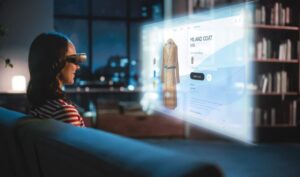

The Power of 3D Product Visualization: Transforming Industries
In today’s dynamic business landscape, where attention spans are fleeting and visual appeal reigns supreme, companies are in a constant quest to captivate consumers amidst a sea of options. This pursuit has led to a pivotal shift in product showcasing, marked by the revolutionary advent of 3D product visualization. This technology has emerged as the beacon of modern marketing, empowering businesses across diverse sectors to transcend the limitations of conventional product displays.
This new tech has allowed companies to wield the ability to create immersive and captivating visual narratives. Thereby transcending the boundaries set by traditional textual descriptions and static images. This article serves as a gateway to explore the realm of 3D product visualization, unraveling its transformative impact, unlocking its manifold advantages, and spotlighting the industries poised to undergo a paradigm shift through its integration.
What is 3D Product Visualization?


In its essence, 3D product visualization crafts lifelike, detailed three-dimensional models using advanced digital tools. These models let viewers virtually interact and explore the product from all perspectives. Unlike flat images or text, it offers an immersive experience, allowing customers to customize and simulate product usage.
The process involves stages like 3D modeling, texturing, and rendering. Digital artists use specialized software to meticulously shape the product virtually during modeling. Texturing then adds realistic materials, while rendering simulates lighting, shadows, and reflections, breathing life into the model.
Benefits of 3D Product Visualization


The adoption of this amazing tech brings a wide range of benefits for businesses and customers alike. Let’s take a closer look at some of the key advantages:
Superior Product Presentations
3D product visualization enables businesses to craft captivating presentations, spotlighting their products brilliantly. These detailed visualizations offer customers a comprehensive grasp of the product’s design, features, and usability. Presenting products in this visually enticing manner allows businesses to leave a lasting impact and distinguish themselves in a competitive landscape.
Enhanced Customer Experience
3D product visualization offers a major edge by immersing customers in interactive experiences. It bridges the gap between the physical and digital realms, letting customers virtually examine products. They can rotate, zoom, and explore from various angles, grasping size, proportions, and finer details. This level of interaction deepens the connection and enriches the overall customer journey.
Increased Sales and Reduced Return Rates
The immersive and realistic nature of 3D product visualizations significantly boosts sales. Clear and accurate representations build customer confidence and trust in purchasing decisions. Enabling customers to visualize product fit in their lives reduces disappointment and returns, resulting in increased sales and lower return rates for businesses.
Improved Communication and Collaboration
In industries such as manufacturing and product design, effective communication and collaboration are critical for success. 3D product visualization allows teams to communicate complex design concepts and requirements more effectively. With a visual representation of the product, stakeholders can provide clear feedback, suggest modifications, and identify potential issues early in the development process. This streamlined communication improves overall efficiency and reduces costly errors.
Customization and Experimentation
3D product visualization revolutionizes offerings for businesses with customizable products. Customers can instantly personalize colors, materials, and features. This customization elevates the buying journey while showcasing the array of options available. Moreover, designers and engineers can experiment with various designs, testing feasibility without physical prototypes, thus saving time and resources.
Cost and Time Savings
Traditionally, creating physical prototypes for testing and validation can be time-consuming and expensive. 3D product visualization removes this need by using virtual models for testing and analysis. This slashes both time and expenses linked with product development. Businesses can speed up iterations, spot and fix design issues earlier, and bring products to market swiftly. Hence saving the time and cost.
Exploring New Product Ideas
Innovation is crucial for businesses to stay competitive in today’s rapidly evolving market. 3D product visualization allows businesses to explore new product ideas and concepts without the need for extensive resources or investments. By quickly visualizing and testing different design possibilities, businesses can assess the viability and market potential of new products before committing to full-scale production. This ability to experiment and iterate fuels creativity and drives innovation.
Industries Benefiting from 3D Product Visualization


The impact of 3D product visualization extends across various industries, transforming the way businesses operate and engage with their customers. Let’s explore some of the key industries that have embraced this technology:
Manufacturing and Product Design
Manufacturers and product designers face the challenge of effectively communicating complex product designs to stakeholders and customers. 3D product visualization enables them to create detailed and realistic digital models of their products. These models can be easily customized and tested for design options and features, helping teams visualize and refine their designs. Virtual prototypes can also be subjected to simulations and analysis, ensuring compliance with safety and quality standards while reducing the need for physical prototypes.
Architecture, Interior Design, and Construction
In the field of architecture, interior design, and construction, 3D product visualization plays a crucial role in conveying design intent and facilitating client communication. Detailed and accurate visual representations of architectural designs help clients visualize spaces, materials, and lighting before construction begins. 3D walkthroughs and virtual tours allow clients to experience the project in a virtual environment, making it easier to identify potential issues and make design modifications. Additionally, rendered images and videos aid in marketing efforts, attracting potential customers and investors.
Entertainment and Gaming
The entertainment industry, particularly gaming, has witnessed significant advancements in visual technology, thanks to 3D product visualization. Game developers and artists utilize 3D visualization to create immersive and realistic gaming environments, characters, and objects. With the emergence of augmented reality (AR) and virtual reality (VR) technologies, gaming companies can offer more interactive and engaging experiences to their customers. 3D product visualization is also extensively used in the film and television industry to create visually stunning set pieces, characters, and special effects.
Public Attractions
Theme parks and museums always strive for captivating experiences. 3D product visualization, along with AR and VR tech, helps create unique, immersive guest experiences. Theme parks use 3D, AR, and VR for interactive, lifelike rides, immersing visitors in fantastical worlds. Museums employ interactive displays and 3D models, engaging visitors and offering deeper insights into exhibits and historical artifacts.
Retail and eCommerce
Within retail and eCommerce, 3D product visualization proves a potent tool. Online stores offer customers a 360-degree product view, enabling detailed inspection pre-purchase. Augmented reality (AR) lets customers virtually try on clothing, accessories, and furniture, aiding informed decisions. Retailers using 3D visualization see heightened customer engagement, improved conversion rates, and fewer returns.
Fashion, Apparel, and Jewelry
The fashion and Jewelry industries see immense value in 3D product visualization. It empowers designers and manufacturers to craft stunning, personalized products. Designers experiment with styles, materials, and colors to meet customer expectations. It streamlines production by spotting design flaws early, cutting waste, and improving efficiency. 3D product configurators empower customers, elevating the shopping experience through personalization.
Medical Devices and Life Sciences
In the field of healthcare, 3D product visualization has proven invaluable in designing and developing medical devices and prosthetics. By converting body scans and medical imaging data into 3D models, healthcare professionals can create custom-fit prosthetics and implants, improving patient outcomes.
Manufacturers in the healthcare industry also leverage 3D visualization to design and test new medical devices, ensuring their safety and efficacy before production. The ability to visualize and interact with 3D models enhances collaboration between medical professionals, engineers, and manufacturers, leading to better patient care.
Final Verdict
The impact of 3D product visualization is evident, reshaping industries and redefining how businesses engage with their products. Across manufacturing, architecture, entertainment, and retail, diverse sectors utilize 3D visualization for improved customer experiences, boosted sales, and innovative strides. Leveraging this tech keeps businesses competitive, offering immersive experiences to customers. If adopted, 3D product visualization can unlock potential and drive success in various industries, whether you’re a designer, retailer, or healthcare professional.


Leave a Reply